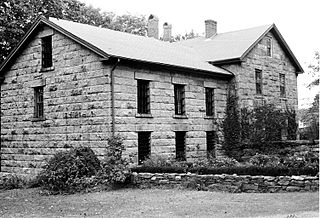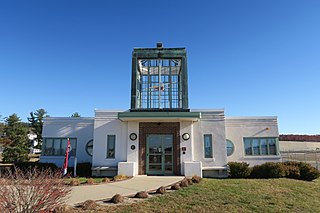
The Reed Homestead (circa 1809) is a historic home currently operated as a historic house museum in Townsend Harbor, Massachusetts.

The Reed Homestead (circa 1809) is a historic home currently operated as a historic house museum in Townsend Harbor, Massachusetts.
The house is notable mainly for its well-preserved murals on the second floor, attributed to Rufus Porter, founder of Scientific American magazine. The murals date from around 1800 to 1835, and are among the best-preserved examples anywhere of Porter's work. Although it is believed that about 160 Porter murals once existed in homes throughout New England, most have subsequently been destroyed by wallpapering or fading due to sunlight.
The two-story, federal-style house was built circa 1809 for Oliver Reed Jr., and inhabited by four generations of the Reed family. In 1973 it was purchased by the Townsend Historical Society. Nearly everything inside is original, from the wide pine floors to the crown glass windows to the mammy bench in the kitchen. Some modernization has taken place (e.g. electricity was installed in the 1920s) but the house retains much of its nineteenth century flavor.
In addition to the murals, the house contains a clothing collection and many original furnishings.
Today, the home is a nonprofit house museum operated by the Townsend Historical Society. It is located at 72 Main Street (Route 119) and open Tuesday through Friday, 9 a.m. to 2 p.m.

The Florida State Capitol in Tallahassee, Florida, is an architecturally and historically significant building listed on the National Register of Historic Places. The Capitol is at the intersection of Apalachee Parkway and South Monroe Street in downtown Tallahassee, Florida.

The Stevens–Coolidge House and Gardens, formerly known as Ashdale Farm, is a garden and historic home located on 91 acres (37 ha) at 153 Chickering Road in North Andover, Massachusetts. Helen Stevens Coolidge's family first acquired the farm in 1729, and from 1914 to 1962 it was her summer home with husband John Gardner Coolidge, diplomat, descendant of Thomas Jefferson, and nephew of Isabella Stewart Gardner. It is now a nonprofit museum operated by The Trustees of Reservations.

Stony Point Battlefield is a historic site in Rockland County, New York; the location of the 1779 Battle of Stony Point during the American Revolutionary War. It is a National Historic Landmark and has a museum.

The Rebecca Nurse Homestead is a historic colonial house built ca. 1678 located at 149 Pine Street, Danvers, Massachusetts. It had many additions through the years, eventually being historically restored and turned into a museum in 1909. Today it is owned and operated by the Danvers Alarm List Company, a volunteer non-profit organization, and is part of the Salem Village Historic District.

The Corydon Historic District is a national historic district located in Corydon, Indiana, United States. The town of Corydon is also known as Indiana's First State Capital and as Historic Corydon. The district was added to the National Register of Historic Places in 1973, but the listing was amended in 1988 to expand the district's geographical boundaries and include additional sites. The district includes numerous historical structures, most notably the Old Capitol, the Old Treasury Building, Governor Hendricks' Headquarters, the Constitution Elm Memorial, the Posey House, the Kintner-McGrain House, and The Kintner House Inn, as well as other residential and commercial sites.

The Rhode Island Historical Society is a privately endowed membership organization, founded in 1822, dedicated to collecting, preserving, and sharing the history of Rhode Island. Its offices are located in Providence, Rhode Island.

The Monmouth County Historical Association was established in 1898 by a group of county residents headed by professional educator Caroline Gallup Reed. They soon incorporated in order “to discover, procure, preserve and perpetuate whatever relates to the history of Monmouth County.” In 1931, the present Museum and Library, a brick Georgian-style building designed by architect J. Hallam Conover, was constructed in Freehold, the county seat of Monmouth County, New Jersey. The enthusiasm generated by the announcement of a new headquarters brought in numerous contributions of furniture, artifacts, paintings, rare documents and books.

The Coffin House is a National Historic Landmark located in the present-day town of Fountain City in Wayne County, Indiana. The two-story, eight room, brick home was constructed circa 1838–39 in the Federal style. The Coffin home became known as the "Grand Central Station" of the Underground Railroad because of its location where three of the escape routes to the North converged and the number of fleeing slaves who passed through it.
The Newport Historical Society is a historical society in Newport, Rhode Island that was chartered in 1854 to collect and preserve books, manuscripts, and objects pertaining to Newport's history.

The Bronck House, also known as the Pieter Bronck House, is a historic house museum west of Coxsackie in Greene County, New York. With a construction history dating to 1663, it is believed to be the oldest surviving building in Upstate New York, and is a well-preserved example of early Dutch and Swedish Colonial architecture. It was declared a National Historic Landmark in 1967. It is now a museum property managed by the county historical society.

The Museum of Work and Culture is a museum in Woonsocket, Rhode Island, that features exhibits focusing on the city's textile manufacturing heritage. The museum is operated by the Rhode Island Historical Society and located at 42 South Main Street in Market Square in the Blackstone River Valley National Heritage Corridor.

The John Coltrane House is a historic house at 1511 North 33rd Street in Philadelphia, Pennsylvania, USA. A National Historic Landmark, it was the home of American saxophonist and jazz pioneer John Coltrane from 1952 until 1958. On his death in 1967 the house passed to his cousin, who sold it in 2004. Efforts for restoration and reuse as a jazz venue are ongoing as of 2013.

The Smith–Harris House, listed on the National Register of Historic Places as the Thomas Avery House, is a 2+1⁄2-story clapboarded Greek Revival home on Society Road in East Lyme, Connecticut. It is believed that the farmhouse was built in 1845–1846 as a wedding gift for Thomas Avery and Elizabeth Griswold. It remained in the Avery family until 1877, when it was purchased by William H. Smith. By the 1890s, the farm was managed by Smith's younger brother, Herman W. Smith, and nephew, Frank A. Harris. In 1900, the two married Lula and Florence Munger, sisters, and both resided in the house. In 1955, the house was sold to the Town of East Lyme, and the sisters continued to live in the house until requiring a nursing home. The house was saved from demolition by citizens and restored. It opened on July 3, 1976, as a historic house museum, operated and maintained by the Smith–Harris House Commission and the Friends of Smith–Harris House. It is open from June through August and throughout the year by appointment. The Smith–Harris house was added to the National Historic Register of Places on August 22, 1979.

The South County History Center, which formerly operated as the Pettaquamscutt Historical Society, is a nonprofit organization in Kingston, Rhode Island, United States, that preserves and interprets the material culture of South County through exhibits and study of archival, library and artifact collections.
The Oyster Bay History Walk is a path through downtown Oyster Bay, New York that leads the walker to 30 historic sites. It is a 1-mile loop and is the first certified American Heart Association Start! Walking Path on Long Island.

The architectural structures of Fredericksburg, Texas are often unique to the Texas Hill Country, and are historical edifices of the German immigrants who settled the area in the 19th Century. Many of the structures have historic designations on a state or national level. The Gillespie County Historical Society is actively involved in assisting with preservation.

The Aviation Museum of New Hampshire is a historical museum operated by the New Hampshire Aviation Historical Society, a non-profit group that preserves the history of flight in the U.S. state of New Hampshire. The organization's goal is to preserve New Hampshire aviation history through a series of dynamic and hands-on exhibits and programs, as the museum's website states. The museum operates in the 1937 Manchester Airport terminal building. The museum expanded in 2011.
The Yates County Genealogical and Historical Society focuses on the history of Yates County, New York. It operates the Yates History Center, which consists of three museums in the village of Penn Yan, New York: the 19th century period Oliver House Museum, the L. Caroline Underwood Museum with historic decorative arts items and displays of local history, and the adjacent Scherer Carriage House which features exhibits about the local evangelist known as the Public Universal Friend.

The Captain Enoch Remick House is part of a historic homestead located in the town of Tamworth, New Hampshire, United States. In 1996, the house—along with a complex of five surrounding outbuildings and approximately 69 acres (28 ha) of field, pasture and woodland—was listed on the National Register of Historic Places for its significance in art, architecture, and local agriculture. It now operates under the auspices of the Remick Country Doctor Museum & Farm.